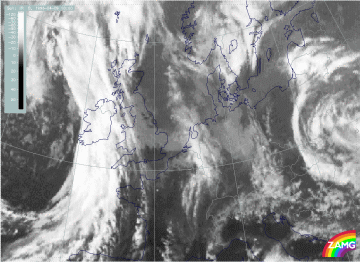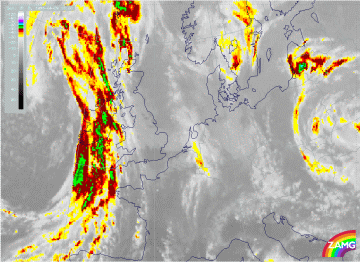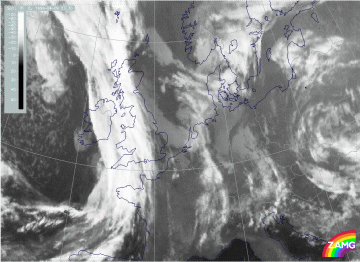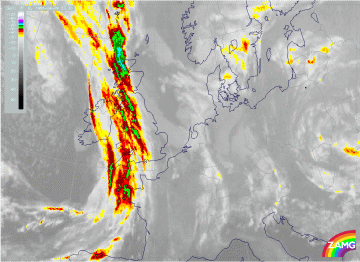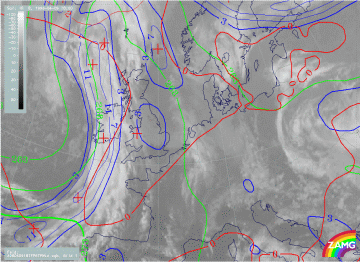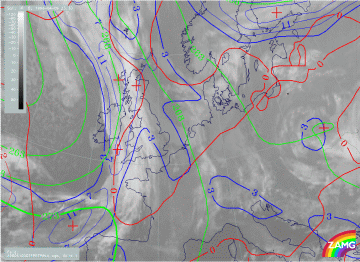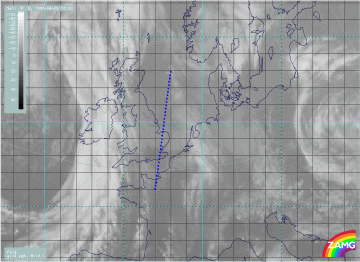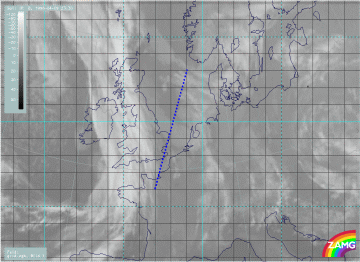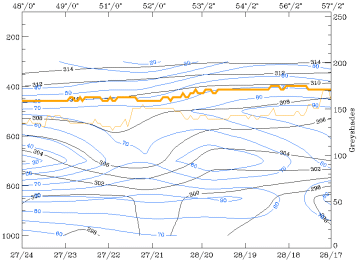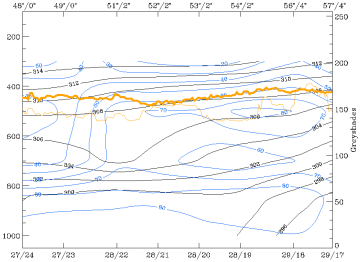09 - 10 April 1996 - Mesoscale Cloud Band: Analysis For "Special Investigation": 09 April 18.00 UTC To 10 April 00.00 UTC
|
09 April 1996/18.00 UTC - Meteosat IR image
|
09 April 1996/18.00 UTC - Meteosat IR enhanced image
|
The satellite image at 18.00 UTC (left image) shows the small scale cloud band extending from the North Sea (at approximately 53N/04W) above the Netherlands, over south-east England to the west coast of England where it merges with the rest of the cloud band of the Cold Front in Warm Advection (compare Cold Front in Warm Advection ). Compared with the situation at 12.00 UTC (compare Mesoscale Cloud Band: Diagnosis for 09 April 12.00 UTC ) the cloud band still consists of low (warm) cloud tops. Only above the Netherlands can higher cloud tops be observed (right image).
|
09 April 1996/23.30 UTC - Meteosat IR image
|
09 April 1996/23.30 UTC - Meteosat IR enhanced image
|
At 23.30 UTC the image (left image) shows the cloud band extending from the North Sea (at approximately 54N/05E) crossing the Netherlands and the North Sea coast of England to south-east Scotland where it merges with the frontal cloud band. Compared with the image from 18.00 UTC it can be observed that the cloud tops within the eastern part are getting warmer, especially the tops above the Netherlands (right image).
|
09 April 1996/18.00 UTC - Meteosat IR image; blue: thermal front parameter (TFP) 500/850 hPa, green: equivalent thickness 500/850 hPa,
red: temperature advection - WA 1000 hPa
|
09 April 1996/00.00 UTC - Meteosat IR image; blue: thermal front parameter (TFP) 500/850 hPa, green: equivalent thickness 500/850 hPa,
red: temperature advection - WA 1000 hPa
|
Superimposed on both images above is the parameter combination of thermal front parameter, equivalent thickness and field of warm advection, which describes the thermal situation within the lower part (up to 500 hPa) of the troposphere. As at 12.00 UTC (compare Mesoscale Cloud Band: Diagnosis for 09 April 12.00 UTC ) the ECMWF model at this point does not analyze this cloud band at all. The field of equivalent thickness shows neither a crowding zone at 18.00 UTC (left image) nor at 00.00 UTC (right image) within the area of the small scale cloud band. The second superimposed parameter, the TFP, has at 18.00 UTC only values of approximately 3 units above the southern part of England (western part of the cloud band). Within the rest of the cloud band (eastern part) the front parameter has values less than 3 units. The situation at 00.00 UTC is nearly the same as at 18 UTC. Within the western part, above the North Sea coast of England, the TFP is characterized by values of about 3 units. Within the cloud band east of approximately 05E the values of the front parameter are below the threshold of 3 units. The third superimposed parameter is the field of warm advection. As iat 12 UTC the whole small scale cloud band is within weak warm advection.
Summing up, when using the model at this point, it is not possible to classify clearly this cloud band. Therefore to classify this system a vertical cross section through the cloud band must be used.
|
09 April 1996/18.00 UTC - Meteosat IR image; ECMWF grid superimposed; position of vertical cross section indicated
|
09 April 1996/23.30 UTC - Meteosat IR image; ECMWF grid superimposed; position of vertical cross section indicated
|
Both images above contain the superimposed location of the computed cross sections (dashed blue line).
|
09 April 1996/18.00 UTC - Vertical cross section; black: isentropes (ThetaE), blue: relative humidity, orange thin: IR pixel values,
orange thick: WV pixel values
|
09 April 1996/23.30 UTC - Vertical cross section; black: isentropes (ThetaE), blue: relative humidity, orange thin: IR pixel values,
orange thick: WV pixel values
|
The cross section from 18.00 UTC (left image) shows the cloud band (pixel values of the IR grey shades) between the ECMWF gridpoints 27/22 and 28/20. Like the cross section at 12.00 UTC (compare Mesoscale Cloud Band: Diagnosis for 09 April 12.00 UTC ) the field of the equivalent potential temperature contains an Occlusion - like crowding zone between 800 and 500 hPa. The third superimposed parameter, the field of relative humidity, shows in the cloud band area high values of about 70 to 90% within the lower layers of the troposphere (from the surface up to approximately 750 hPa).
The right cross section shows the vertical distribution of the equivalent potential temperature and of the relative humidity at 00 UTC. Within this cross section the cloud band is situated between the ECMWF gridpoints of approximately 28/22 and approximately 28/20. In contrast to the cross section at 18.00 UTC, the equivalent potential temperature shows already a weaker crowding zone, especially at the cloud edge which is situated in front of the approaching front (left area within the cross section). This is caused by the continously decreasing area between this small scale cloud band and the frontal cloud band. The result of this process is that the air between both systems is getting warmer and the typical Occlusion - like trough of the isentropes is not as pronounced as within the cross sections at 12 and 18 UTC. The third parameter, the field of relative humidity, shows again high values within the lower layers of the troposphere and lower values within the higher layers.
Summing up, this case study is an example where cross sections are an additional tool to classify, to derive more information or even to gain a better understanding of the meteorological background of weather systems.
